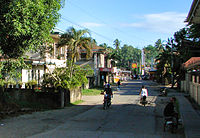
Photo from wikipedia
The Paris–Abu Bayan area located along the Darb El Arbaein road is involved in the New Valley Project in the Egyptian Western Desert (EWD) as part of ongoing efforts since… Click to show full abstract
The Paris–Abu Bayan area located along the Darb El Arbaein road is involved in the New Valley Project in the Egyptian Western Desert (EWD) as part of ongoing efforts since the 1960s. In this dryland area, groundwater stored in the Nubian Sandstone Aquifer System (NSAS) serves as the only water resource for a number of different uses. A major concern is the significant groundwater withdrawals from 74 pumped wells since the beginning of agricultural activities in 2000. The recent rapid expansion of agricultural activity and the lack of sufficient groundwater recharge as a result of unplanned groundwater development have led to severe stress on the aquifer. Field measurements have shown a rapid decline in groundwater levels, creating a crisis situation for this sole source of water in the area. In this study, mathematical modeling of the groundwater system (single aquifer layer) of the Paris–Abu Bayan reclaimed area was implemented using MODFLOW to devise a new strategy for the sustainable use of groundwater, by applying a number of scenarios in a finite-difference program. The conceptual model and calibration were developed by generating and studying the hydrogeological records, NSA parameters, production wells, and water level measurements for 2005 and 2012. Three management scenarios were applied on the calibrated model to display the present and future stresses on this aquifer over a 30-year period (2012–2042). The results clearly show a high decline in the heads of the NSA, by about 13.8 m, due to the continuous withdrawal of water (first scenario: present conditions, 102,473 m3/day). In the second scenario, the water level is expected to decrease significantly, by about 16 m, in most of the reclamation area by increasing the pumping rates by about 25% (over-pumping) to meet the continuous need for more cultivation land in the area. To reduce the large decline in water levels, the third plan tests the aquifer after reducing the water withdrawal by approximately 25%, applying modern irrigation systems, and suggesting two new reclaimed areas in the northeastern and northwestern parts (areas 1 and 2), with 20 new wells, at 500 m3/day/well. The results in this case show that groundwater levels are slightly decreased, by about 9.5 m, while many wells (especially the new wells in the northern part) show a slight decrease in groundwater levels (0.8 m). The results comparison shows that the groundwater level in the modeled area is lowered by 0.3 m/year with an increase in the number of wells to 94 and increased cultivation area by about 18% (third scenario), versus 0.45 m/year and 0.60 m/year recorded for the first and second scenarios, respectively. Therefore, based on the results, the third scenario is recommended as a new strategy for improving groundwater resource sustainability in the region.
Journal Title: Arabian Journal of Geosciences
Year Published: 2018
Link to full text (if available)
Share on Social Media: Sign Up to like & get
recommendations!